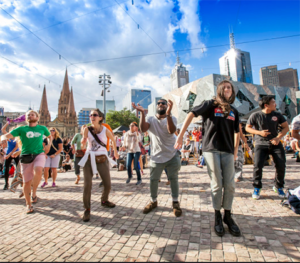Snapshot of increasingly diverse Victoria
Victoria is home to one of the most culturally diverse societies in the world, and is also among the fastest-growing and most diverse states in Australia.
A snapshot taken from newly released census data shows that at the 2016 Census 28.4 per cent of Victoria’s population were born overseas and 49.1 per cent of Victorians were either born overseas or have a parent who was born overseas.
 Most of the overseas-born Victorians came to Australia as migrants hoping to find a better life for themselves and their children.
Most of the overseas-born Victorians came to Australia as migrants hoping to find a better life for themselves and their children.
And a large number of overseas-born Victorians came to Australia as refugees from conflicts including: the Second World War in Europe; in Indo-China; in the republics of the former Yugoslavia; the Horn of Africa; the Middle East; and, Afghanistan.
In 2016, Victoria’s population was 5.93 million. It increased by 10.7 per cent since 2011, compared to 8.8 per cent for the whole of Australia.
Of Victoria’s total population, 28.4 per cent were born overseas in over 200 countries, 26 per cent spoke a language other than English at home and 59 per cent followed one of more than 130 different faiths.
Victorian’s migration trends are changing. Although the largest groups in 2016 were from North West Europe and Southern and Eastern Europe due to their long settlement history, their percentage shares are declining.
Those born in South-East and North-East Asia, Southern and Central Asia have increased significantly in numbers and percentage share as a result of more new arrivals in the last two censuses.
Among the top 15 ranked countries of birth in 2016, the largest percentage increases were for those born in Pakistan (129.9 per cent), China (71.1 per cent), India (51.9 per cent), Philippines (35.0 per cent), Sri Lanka (26.9 per cent) and Malaysia (25.8 per cent).
Percentage decreases were highest for Scotland (-12.5 per cent), Italy (-8.3 per cent), Germany (-6.1 per cent) and Greece (-5.5 per cent).
Not surprisingly, English ancestry still ranks top (23.7 per cent) of total responses to the census, followed closely by Australian ancestry (22.1 per cent).
The rest of the top ancestries are represented by ancestries from source countries of more established migrants and from rapidly increasing source countries from Asia.
The census data reveals the City of Greater Dandenong has the highest proportion of its population born overseas, (57.7 per cent), compared to an overall proportion of 28.4 per cent for the state.
Other Local Government Authorities with high proportions of overseas-born include the City of Melbourne (55.7 per cent), Monash (49.1 per cent), Brimbank (47.9 per cent) and Wyndham (41.6 per cent).
These LGAs include large, outlying suburbs and new residential growth areas.
Victorians with a religion have decreased by 3.3 per cent, from 3,614,939 in 2011 to 3,493,950 in 2016.
Those with no religion increased by 49.4 per cent from 1,256,143 in 2011 to 1,876,738 in
2016.
The largest three religions: Western Catholic, Anglican Church and Uniting Church maintained their rankings, although they experienced a significant decrease in number of followers.
The other top ranking religions, while not as numerous as the Christian faiths, have experienced significant percentage increases, with Sikhism increasing to 79.2 per cent, Hinduism by 62.3 per cent, Islam by 29 per cent and Buddhism 7.9 per cent.












